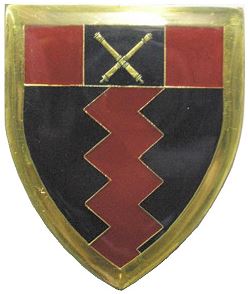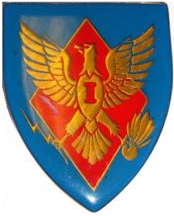
A battalion is a military unit, typically consisting of 300 to 1,200 soldiers commanded by a lieutenant colonel, and subdivided into a number of companies. In some countries, battalions are exclusively infantry, while in others battalions are unit-level organizations.

The 36th Infantry Division ("Arrowhead"), also known as the "Panther Division", "Lone Star Division", "The Texas Army", or the "T-patchers", is an infantry division of the United States Army and part of the Texas Army National Guard. It was organized during World War I from units of the Texas and Oklahoma National Guard. As an all-Texas unit, it was called for service for World War II 25 November 1940, was sent to the European Theater of Operations in April 1943, and returned to the Texas Army National Guard in December 1945.

The 1st Infantry Division is a combined arms division of the United States Army, and is the oldest continuously serving division in the Regular Army. It has seen continuous service since its organization in 1917 during World War I. It was officially nicknamed "The Big Red One" after its shoulder patch and is also nicknamed "The Fighting First." The division has also received troop monikers of "The Big Dead One" and "The Bloody First" as puns on the respective officially sanctioned nicknames. It is currently based at Fort Riley, Kansas.

The 34th Infantry Division is an infantry division of the United States Army, part of the National Guard, that participated in World War I, World War II and multiple current conflicts. It was the first American division deployed to Europe in World War II, where it fought with great distinction in the Italian Campaign.

The Royal Regiment of New Zealand Artillery is the artillery regiment of the New Zealand Army. It is effectively a military administrative corps, and can comprise multiple component regiments. This nomenclature stems from its heritage as an offshoot of the British Army's Royal Artillery. In its current form it was founded in 1947 with the amalgamation of the regular and volunteer corps of artillery in New Zealand. In 1958 in recognition of services rendered it was given the title the Royal Regiment of New Zealand Artillery.

The Royal Regiment of Australian Artillery, normally referred to as the Royal Australian Artillery (RAA), is a Regiment of the Australian Army descended from the original colonial artillery units prior to Australia's federation. Australia's first guns were landed from HMS Sirius and a small earthen redoubt built, near the present-day Macquarie Place, to command the approaches to Sydney Cove. The deployment of these guns represents the origins of artillery in Australia. These and subsequent defences, as well as field guns, were operated by marines and the soldiers of infantry regiments stationed in Australia. Unlike their British and Canadian equivalents, there are no regiments of horse artillery in the order of battle of the Royal Australian Artillery. The First World War saw the raising of 60 field, 20 howitzer, and two siege batteries along with the heavy and medium trench mortar batteries. Until 19 September 1962 the Australian Artillery was referred to as the 'Royal Australian Artillery', however, on this date Queen Elizabeth II granted the RAA the title of 'The Royal Regiment of Australian Artillery'. The Regiment today consists of Regular and Reserve units.

The Sandfontein Artillery Regiment is a reserve artillery regiment of the South African Army.
Operation Prone was a proposed military operation by the South African Defence Force (SADF) and South West African Territorial Force (SWATF) during the South African Border War and Angolan Civil War between May and September 1988. With the advance of the 50th Cuban Division towards Calueque and the South-West Africa border, the SADF formed the 10 SA Division to counter this threat. The plan for Operation Prone had two phases. Operation Linger was to be a counterinsurgency phase and Operation Pact a conventional phase.
The 4th Regiment, Royal Australian Artillery is an artillery unit of the Australian Army. Currently it provides close artillery support to the 3rd Brigade and is based at Chau Pha Lines, Lavarack Barracks in Townsville, Queensland. The regiment was raised in its current form in 1960 and is currently re-equipping with M777A2 lightweight towed howitzers. The regiment deployed during Australia's commitment to the Vietnam War and has subsequently deployed to Singapore and East Timor.

The Sri Lanka Artillery (SLA) is the artillery arm of the Sri Lanka Army. It is made up of ten regular regiments and two volunteer regiments. The SLA is headquartered at Panagoda Cantonment, Panagoda.

The Regiment of Artillery is a combat/fighting arm of the Indian Army, which provides massive firepower during all ground operations of the Indian Army. It is a successor to the Royal Indian Artillery (RIA) of British Indian Army, which itself traces its origins to the formation of Bombay Artillery in 1827.
K (Hondeghem) Battery is a battery of 5th Regiment Royal Artillery in the Royal Artillery. It currently serves in the Surveillance and Target Acquisition role and is equipped with MAMBA, a type of weapon locating radar.

7 South African Infantry Division was a formation of the South African Army, active from the 1960s to 1999.

10 Artillery Brigade was a South African Defence Force formation designed for mass artillery barrages, mainly for the 7th South African Infantry Division or 8th South African Armoured Division, as well as an ad hoc formation during Operation Prone, when needed and detached and reattached where required. Smaller components would then be used at the battlegroup level.

14 Artillery Regiment was a South African Artillery unit whose name was used twice. It was re-established in Potchefstroom in 1974 and was a full-time unit responsible for the training of Permanent Force and National Service personnel.

25 Field Artillery Regiment was an artillery regiment of the South African Artillery.

24 Field Artillery Regiment was an artillery regiment of the South African Artillery.

1 Locating Regiment was an artillery locating regiment of the South African Artillery. The regiment provided divisional troops but was typically organized to allocate locating batteries to brigades.
1st Medium Regiment was an artillery regiment of the South African Army, after World War II.
20 SATA Regiment, nicknamed the ‘Alma Mater of Locators’ is a Surveillance and Target Acquisition (SATA) artillery regiment which is part of the Regiment of Artillery of the Indian Army.
















